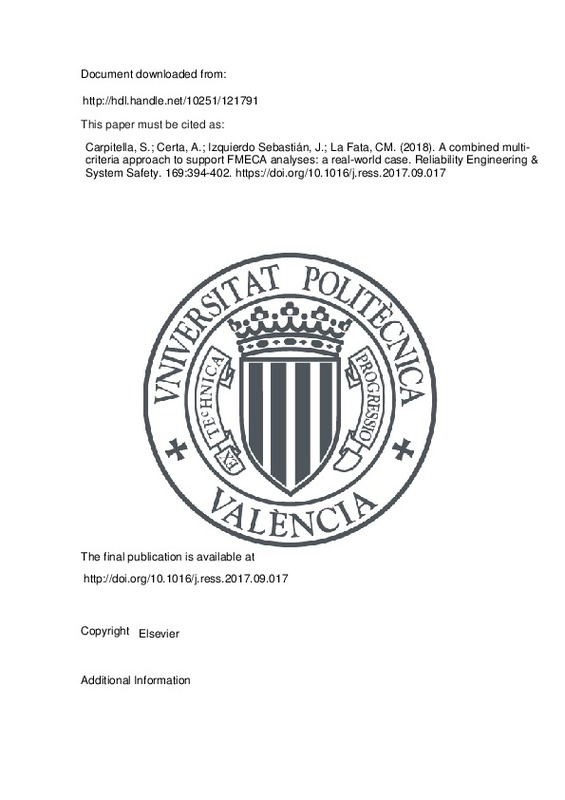JavaScript is disabled for your browser. Some features of this site may not work without it.
Buscar en RiuNet
Listar
Mi cuenta
Estadísticas
Ayuda RiuNet
Admin. UPV
A combined multi-criteria approach to support FMECA analyses: a real-world case
Mostrar el registro sencillo del ítem
Ficheros en el ítem
| dc.contributor.author | Carpitella, Silvia
|
es_ES |
| dc.contributor.author | Certa, A.
|
es_ES |
| dc.contributor.author | Izquierdo Sebastián, Joaquín
|
es_ES |
| dc.contributor.author | La Fata, C. M.
|
es_ES |
| dc.date.accessioned | 2019-06-07T20:06:54Z | |
| dc.date.available | 2019-06-07T20:06:54Z | |
| dc.date.issued | 2018 | es_ES |
| dc.identifier.issn | 0951-8320 | es_ES |
| dc.identifier.uri | http://hdl.handle.net/10251/121791 | |
| dc.description.abstract | [EN] The paper proposes an approach that combines reliability analyses and multi-criteria decision methods to optimize maintenance activities of complex systems. A failure mode, effects, and criticality analysts (FMECA) is initially performed and the fuzzy TOPSIS (FTOPSIS) method is then applied to rank previously identified failure modes. For prioritization, failure modes are assessed against three evaluation criteria that differ from those traditionally involved in risk priority number (RPN) computation (i.e. severity, occurrence and detection). Two criteria refer to the maintenance management reflecting the operational time taken by the maintenance activity performed after the occurrence of a specific fault, and the way such an action is executed. The third criterion reflects the classical frequency of the occurrence of faults. To further develop previous research, the analytic hierarchy process (AHP) is herein applied to weight evaluation criteria and a group of experts is involved with aspects associated with the considered criteria. The approach is applied to a real-world case study, showing that the obtained results represent a significant driver in planning maintenance activities. To test the influence of criteria weights on ranking results, a sensitivity analysis is carried out by varying the vector of criteria weights obtained from the group decision process. (C) 2017 Elsevier Ltd. All rights reserved. | es_ES |
| dc.language | Inglés | es_ES |
| dc.publisher | Elsevier | es_ES |
| dc.relation.ispartof | Reliability Engineering & System Safety | es_ES |
| dc.rights | Reconocimiento - No comercial - Sin obra derivada (by-nc-nd) | es_ES |
| dc.subject | Safety-critical analysis | es_ES |
| dc.subject | FMECA | es_ES |
| dc.subject | FTOPSIS | es_ES |
| dc.subject | AHP | es_ES |
| dc.subject.classification | MATEMATICA APLICADA | es_ES |
| dc.title | A combined multi-criteria approach to support FMECA analyses: a real-world case | es_ES |
| dc.type | Artículo | es_ES |
| dc.identifier.doi | 10.1016/j.ress.2017.09.017 | es_ES |
| dc.rights.accessRights | Abierto | es_ES |
| dc.contributor.affiliation | Universitat Politècnica de València. Departamento de Matemática Aplicada - Departament de Matemàtica Aplicada | es_ES |
| dc.description.bibliographicCitation | Carpitella, S.; Certa, A.; Izquierdo Sebastián, J.; La Fata, CM. (2018). A combined multi-criteria approach to support FMECA analyses: a real-world case. Reliability Engineering & System Safety. 169:394-402. https://doi.org/10.1016/j.ress.2017.09.017 | es_ES |
| dc.description.accrualMethod | S | es_ES |
| dc.relation.publisherversion | http://doi.org/10.1016/j.ress.2017.09.017 | es_ES |
| dc.description.upvformatpinicio | 394 | es_ES |
| dc.description.upvformatpfin | 402 | es_ES |
| dc.type.version | info:eu-repo/semantics/publishedVersion | es_ES |
| dc.description.volume | 169 | es_ES |
| dc.relation.pasarela | S\343712 | es_ES |







![[Cerrado]](/themes/UPV/images/candado.png)

